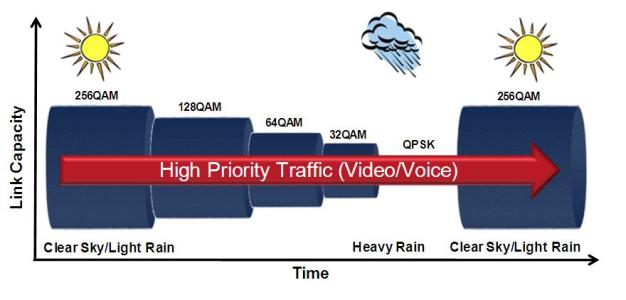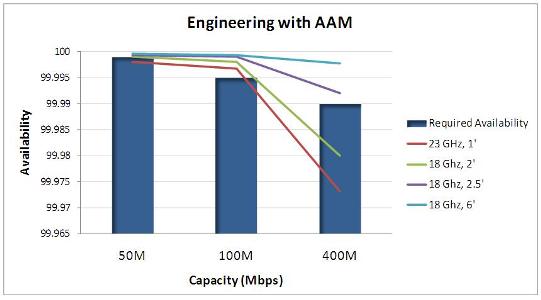In traditional, static TDM microwave networks, there is a single capacity, such as 155Mbps, and the link is either up or down. The downtime can be predicted and calculated through well established rain and multi-path models. With automatic adaptive modulation(AAM), there are multiple modulation levels, each with a different capacity and link budget, and therefore different associated availability on a link. Adaptive modulation will always try to operate in the highest capacity mode and when there is a fade event the system will switch to a lower modulation to get an improved link budget, but at a lower capacity. If there is further fade, the system will switch to a lower mode again, further improving the link budget. A system will only have a complete outage once it is already in the lowest mode, and there is a fade below the link budget of this mode.
The following diagram illustrates the operation of AAM during a fade event.

The dynamic nature of adaptive modulation makes link engineering more complex than simply engineering to a single availability for a target capacity. These multiple modes mean that to take advantage of adaptive modulation, multiple service levels need to be defined by the user. For example, an operator may require 50Mbps of critical traffic which must have 99.999% availability and 100mbps of gold level traffic at 99.995% availability, with an additional 300Mbps at 99.99% availability. A link with adaptive modulation can be used to meet each of these availability targets. This is compared to a traditional, static link which would have only a single availability and therefore even if only a small portion of the traffic required high availability, all traffic in the link would have to be engineered to that level, resulting in lower capacity network that is not optimized for the majority of the traffic it carries.
In order to meet these traffic requirements, the operator must engineer the network to each service level and then use the configuration that meets all three availability requirements. This will mean that the availability may be exceeded for some capacities. This method is shown in the chart below, where 18 GHz, 2.5’ antennas meet or exceed the required availability at all capacity levels.

In comparison, a traditional non-AAM system would not be able to deliver 400M and 99.999% availability, even at 18GHz with 6’ antennas.
Depending upon the network environment, any set of criteria can be optimized. If the desire is to maximize capacity in a mixed services network, the operator can now deliver a much higher throughput, while still meeting the desired availability for lower capacity services. This is especially useful for network upgrade scenarios, where licenses and antennas may already be in place. Using this approach, the operator could take an existing 99.999%, 16 T1 link, and upgrade it to an Ethernet AAM system, allowing them to deliver their existing T1s via pseudowire at 99.999% availability, and also gain an additional 350 Mbps of capacity at a lower availability.
Another form of optimization is the minimization spectrum usage. If a system requires 100Mbps of traffic, with multiple traffic types, a static, non-AAM deployment may require a 56 MHz channel, with 16QAM in order to meet the most stringent traffic availability requirements. However, by using AAM, this same traffic and the various availabilities can be engineered into a much smaller channel size, such as 14 MHz using 256 QAM. This would result not only in a more deployable network, but also a reduction in ongoing spectrum costs.
A third area of optimization is antenna size, as many operators are charged monthly leases based upon the diameter of their antenna. In the example we used above, to deliver 400M, while still meeting 99.999% availability for the critical traffic, a traditional static system would require >6’ antennas. However, with adaptive modulation, all of the service levels can be met with 2.5’ antennas, reducing recurring lease costs, and greatly simplifying installation. Inversely, AAM allows longer reach for the same antenna size, enabling operators to address sites that previously were out of reach due to their link length.
As discussed, there are many potential benefits to adaptive modulation, but in order for operators to truly take advantage of this, it is also important that the microwave system have priority queuing. In addition, the operator must properly engineer the traffic queues to fully utilize adaptive modulation. AAM requires a multi-level queuing system, allowing each of the traffic classes to be assigned a different priority and associated guaranteed bandwidth. For example, critical voice traffic and control traffic would be assigned the highest priority, with enough guaranteed bandwidth to ensure that the traffic is always served, even during a modulation switch.
Some network operators prefer to perform their queuing and traffic management in the Ethernet switching layer, rather than the microwave layer. This is understandable, as many switches provide very advanced traffic management capabilities. However, for these switches to properly queue and shape traffic, it is imperative that they understand the capacity of the microwave pipe which they are connected to. This is a complicated task with adaptive modulation, as the capacity is dynamic. In order for the switch to be aware of the current link capacity in this dynamic environment, either proprietary signaling is required, or both the switch and microwave layer must communicate via protocols such as 802.3ah. This allows the microwave layer to advertise its current capacity to the switching layer, enabling the switch to prioritize traffic accordingly.
Adaptive modulation has many benefits in a multi-service network, allowing the operator to engineer multiple capacities to multiple availabilities. This results in a network that is optimized to areas which offer the greatest benefit to the operator, whether it be antenna size, spectrum usage, capacity or network coverage. In order to properly harness these benefits, it is important that the operator also develop a switching and prioritization strategy and properly engineer and assign queues for each of the desired service levels.
Feel free to post questions and comments here.
